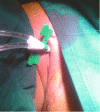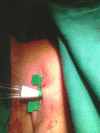Skin fold technique for central venous catheter fixation; Comparison with conventional method for postopration infections
- PMID: 28210584
- PMCID: PMC5307601
Skin fold technique for central venous catheter fixation; Comparison with conventional method for postopration infections
Abstract
Background: Central Venous Catheters (CVCs) are used not only as a tool to access to central venous system, but also for hemodynamic monitoring, parenteral nutrition, chemotherapy and hemodialysis. The use of CVCs is associated with some complications notably infections that are troublesome both to patient and physician. We conducted this study to examine catheter fixation with skin fold technique and to evaluate risk of catheter infection in this method and compare it to conventional technique. Methods: This study is a controlled clinical trial (IRCT: IRCT2015081723229N1) and all cases are patients over 18 years, admitted to Hasheminejad Kidney Center from 2011 to 2012, who needed an internal jugular venous catheter for hemodialysis. Finally, two hundred and twenty two patients entered the study. We used chi square test and logistic regression for data analysis. P-value less than 0.05 was considered significant. Results: In this study Mean±SD age of patients was 54.50±15.71 years. Mean ±SD ages of patients in the case and control group were 54.56±16.43 and 54.42±14.84 years, respectively. The rate of catheter infection significantly decreased with skin fold technique: Five patients (3%) in case group and 13 patients (16%) in control group had infection (p=0.002). Conclusion: The findings of this study demonstrated that catheter fixation with skin fold could be an appropriate technique in comparison with current conventional method. However, further studies on other possible and unpredictable complications of this technique is required.
Keywords: Central venous catheter; Fixation; Infection.
References
-
- Pittet D, Tarara D, Wenzel RP. Nosocomial bloodstream infection in critically ill patients: excess length of stay, extra costs, and attributable mortality. JAMA. 1994;271:1598–601. - PubMed
-
- Arnow PM, Quimosing EM, Beach M. Consequences of intravascular catheter sepsis. Clin Infect Dis. 1993;16:778–84. - PubMed
-
- Richards MJ, Edwards JR, Culver DH, Gaynes RP. Nosocomial infections in medical intensive care units in the United States. Crit Care Med. 1999;27:887–92. - PubMed
-
- Raad I. Intravascular-catheter-related infections. Lancet. 1998;351:893–8. - PubMed
-
- Merrer J, De Jonghe B, Golliot F, Lefrant JY, Raffy B, Barre E. et al. Complications of femoral and subclavian venous catheterization in critically ill patients: a randomized controlled trial. JAMA. 2001;286:700–7. - PubMed
LinkOut - more resources
Full Text Sources




